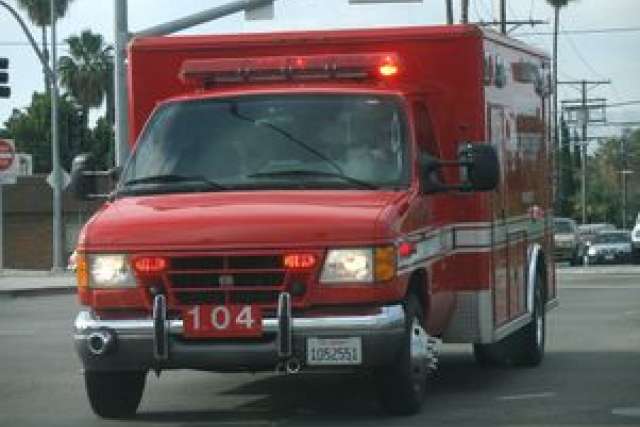A consortium led by UCLA physicians has found that paramedics can safely start providing people with medication in the first minutes after the onset of a stroke instead of waiting for them to receive treatment at a hospital.
Although the drug tested, magnesium sulfate, did not improve patient outcomes, the research points to a new method for treating stroke patients quickly.
For people who have suffered a stroke, immediate treatment is key — the more time that passes before the restoration of blood flow, the higher the likelihood that stroke victims will suffer irreversible brain damage.
The study findings indicate that paramedics can give intravenous medications to stroke patients within the “golden hour,” the window during which treatments are most likely to help patients survive and avoid debilitating, long-term neurological damage. That finding is a game-changer, said Dr. Jeffrey Saver, the study’s co-principal investigator and director of the UCLA Stroke Center.
“The trial succeeded in its goal of devising a means to deliver promising drugs to stroke patients in the first minutes, when there’s the greatest amount of brain to save. We have opened a new therapeutic window that is now being used to test other compounds and deliver clot-busting drugs to patients in the field,” said Saver, who also is a professor of neurology at the David Geffen School of Medicine at UCLA. “Stroke is a true emergency condition. Time lost is brain lost — for every minute that goes by without restoration of blood flow, 2 million nerve cells are lost.”
The study appears in the Feb. 5 issue of the New England Journal of Medicine.
The phase 3 Field Administration of Stroke Therapy–Magnesium (FAST–MAG) clinical trial involved collaboration among 315 ambulances, 40 emergency medical service agencies, 60 receiving hospitals, 715 emergency physicians, 210 neurologists, 26 neurosurgeons and 2,988 paramedics in Los Angeles and Orange counties. In the study, half of the 1,700 patients had the study drug administered within 45 minutes, while 74 percent were treated within the golden hour.
“This study involved an unprecedented cooperative effort of paramedics in the field and emergency physicians serving as investigators,” said Dr. Sidney Starkman, co-principal investigator and co-director of the UCLA Stroke Center.
“Through this study we were able to instill permanently in everyone’s mind the idea that ‘time is brain.’ We believe this represents a paradigm shift in the treatment of stroke and potentially numerous other neurological conditions,” said Starkman, who also is professor of emergency medicine and neurology at the Geffen School. “We demonstrated that paramedics not only are eager to provide the best possible patient care, but also are capable of being invaluable partners in an intense, time-dependent clinical trial.”
Today, the only ways to treat strokes caused by blocked blood vessels are to reopen the arteries with tissue plasminogen activator, a clot-busting drug, or to use catheters to remove the clot. But, in general, neither can be done until the patient arrives at the hospital and undergoes a CT scan to rule out bleeding in the brain. Additional treatments can only be offered after that, by which time substantial brain injury may already have occurred.
The FAST–MAG trial used magnesium because in animal studies it dilated blood vessels and increased blood flow in the brain. Magnesium also countered the damaging calcium buildup that occurs when cells are deprived of oxygen. It had been already approved for use in humans, it had a good safety profile and paramedics were familiar with it.
“Now we are tasked with finding a different agent or combination of agents that can improve stroke outcomes within that golden hour,” Saver said. “The ambulance treatment platform can be used around the world to test promising agents.”
Dr. Bill Koenig, medical director of the Los Angeles County Emergency Medical Service Agency, worked closely with Saver and Starkman on the FAST-MAG study.
“To assist paramedic recognition of stroke victims, the nationally recognized Los Angeles Pre-hospital Stroke Screen was developed,” Koenig said. “FAST-MAG also served as an impetus to create the Los Angeles County System of Stroke Hospitals, which every year treats over 10,000 stroke victims. When the day comes that a medication can successfully treat stroke in its early stages, this novel system in Los Angeles will be well positioned to immediately apply the treatment to our patients. I am confident that with the dedicated investigators, along with a finely tuned EMS system, that discovery will be sooner rather than later.”
Dr. Walter Koroshetz, acting director of the National Institute of Neurological Disorders and Stroke, said this study shows that it is possible to get treatments to stroke patients even before they arrive at a hospital.
“Because a blocked blood vessel causes brain damage over minutes to hours, this pre-hospital approach to treatment is sure to be adopted and refined in clinical research studies,” Koroshetz said. “Ultra-early brain salvage in stroke patients will someday surely reduce the tremendous burden of disability and death due to stroke.”
Saver said clinical trials currently being conducted in the U.S., Canada and England are testing new compounds using the early treatment infrastructure created by the FAST–MAG study.
Stroke is the fifth leading cause of death in the U.S. and is a major cause of adult disability. About 800,000 people in the U.S. have strokes each year, and one person dies from a stroke every four minutes, on average.
The study was funded by the National Institute of Neurological Disorders and Stroke at the National Institutes of Health.



